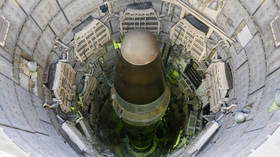Convenient hysteria: US is no longer sugar-coating the fact its nuclear drills are aimed at Russia

Last week, the US conducted a military exercise which simulated a nuclear exchange with Russia and contrary to traditional practices, the Pentagon put that politically explosive designation out in the open.
Any operational directive (or combat order) starts with an overall “enemy” assessment which includes data about the “enemy’s” political situation and military capabilities in the strategic area of interest, as well as possible scenarios of engagement.
Sometimes a particular enemy is designated for these exercises, but usually it’s just given some abstract label (such as blue, green or orange). Even fake countries, like Donovia or Limaria, are invented in some cases.
All the documents pertaining to military exercises are usually classified. Depending on the level of sensitivity, they are marked as “secret” or “top secret.” All this is done in order to avoid souring relations with other states, which might well happen if, for instance, the papers reveal that one nation is role-playing an attack on another.
Nuclear war games are always classified as top secret. Basically, all documents related to strategic nuclear forces operations would be the most restricted military data in any nuclear state.
And then a senior Pentagon official comes out and says, at the DoD Background Briefing on Nuclear Deterrence and Modernization, that they held a "mini-exercise" with a scenario that “included a European contingency where [the troops] were conducting a war with Russia, and Russia decided to use a low-yield limited nuclear weapon against a site on NATO territory.” The exercise was complete with a simulation of a conversation between the secretary of defense and the president “to decide how to respond.”
Forget cautious secrecy, the full transcript was published on the DoD’s website. This makes one think, what is that about? One thing we can say for sure is that it definitely does not help maintain or promote peace and friendly relations in the world.
Also on rt.com Dangerous games: US NUKES Russia in ‘mini exercise’ attended by Pentagon chiefNo reason for war
Let’s talk about the premise that “Russia decides to use a low-yield limited nuclear weapon against a site on NATO territory.”
Current relations between Russia and the US (and the West in general) are far from great, but at the same time there are no burning issues – ideological, economic, territorial or religious in nature – that can only be resolved through military action, let alone require using weapons of mass destruction (WMDs).
In other words, at this point there are no social or political reasons for Moscow and Washington to engage in nuclear warfare. Neither Russia nor the US has any grounds for unlimited use of WMDs, and strategic nuclear weapons in particular.
Moreover, military officials in both countries agree that even using any type of tactical nuclear weapon (let’s say, an artillery shell with an explosive yield of 2 kilotons) will inevitably lead to an exchange of multiple nuclear strikes.
Next, the DoD official said: “You go through the conversation that you would have with the secretary of defense and then with the president, ultimately, to decide how to respond. And so they played out that game, and got a good understanding for how that went.”
This seems highly questionable. The procedure for approving a nuclear strike is similar in both Russia and the US; it’s very clear, extremely centralized and has been practiced for the last seventy years.
There could be no new rules for “the conversation that you would have with the secretary of defense and the president” or a new “good understanding” for how it would go. Both in Russia and the US the response protocol is drilled until it becomes automatic, and every second counts during strategic nuclear strike exercises. In both countries, even the smallest delay in relaying orders will lead to an in-depth investigation at the highest level.
So, there was nothing new to be learned during this US exercise, but it can certainly trigger another round of tensions between Moscow and Washington.
New nukes won’t buy themselves
We can’t rule out that the point of US military exercises with such scenarios is to revive the threat from the East again and later justify additional expenses on building up the advanced strategic nuclear arsenal.
According to Defense News, the US plans to develop a completely new warhead, the W93. The Pentagon is now revealing details about the weapon, what it will replace and when it might be deployed.
Since the introduction of the W88 in the 1980s, all upgrades to warheads have been described as variants. This time, the warhead would be largely a new design.
Right now, there are two submarine-launched nuclear warheads in the arsenal, the W88 and the W76. The latter, which has just completed a service life extension program, now comes in two varieties, the traditional W76-1 and a lower-yield W76-2. Meanwhile, the W88 is in the early stages of a modernization process.
However, each of those two systems will likely require additional modernization in 15-20 years, and their cores are getting increasingly older, even with efforts led by the National Nuclear Security Administration. Given that, the Pentagon believes now is the time to begin developing a future replacement.
The administration’s goal is to have the new nuclear warhead design, which in size would be somewhere between the two existing ballistic missile warheads, fielded by 2040.
Developing a new warhead will require considerable funding, and the government has to find a way to convince US lawmakers to allocate the money, considering the W93 is the first new nuclear warhead design in the last few decades. So, the primary objective of the DoD at this point will be to persuade the US Congress that now is the time to launch this project, which means a military exercise with Russia as the enemy comes in very handy.
Also on rt.com Step to nuclear doomsday: US puts low-yield nukes on submarines to counter made-up Russian ‘strategy'Drills are necessary, hysteria isn’t
Should there be no military exercises involving strategic nuclear forces in order to avoid potential tensions in the international arena? It's unclear whether the Pentagon's "mini-exercise" involved anything beyond the role-played conversation, but normally nuclear drills involve a massive exertion of military force.
In Russia, this could mean ground-based strategic nuclear forces, strategic aviation, air force units with operational-tactical nuclear weapons, naval strategic nuclear forces, submarines with submarine-launched cruise missiles equipped with nuclear warheads, operational-tactical missile forces and artillery units, as well as special forces. In the US, the makeup is approximately the same.
All of these forces have to maintain proper combat readiness, and that is only done through regular exercises and training. However, making up clearly provocative scenarios for military exercises (with a dash of fantasy and fairytales), not to mention advertising them in public, is ill-advised.
Think your friends would be interested? Share this story!
The statements, views and opinions expressed in this column are solely those of the author and do not necessarily represent those of RT.
















